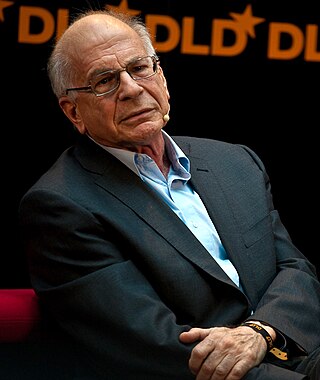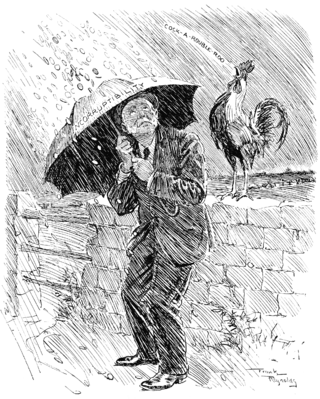
Pessimism is a mental attitude in which an undesirable outcome is anticipated from a given situation. Pessimists tend to focus on the negatives of life in general. A common question asked to test for pessimism is "Is the glass half empty or half full?"; in this situation, a pessimist is said to see the glass as half empty, or in extreme cases completely empty, while an optimist is said to see the glass as half full. Throughout history, the pessimistic disposition has had effects on all major areas of thinking.

The future is the time after the past and present. Its arrival is considered inevitable due to the existence of time and the laws of physics. Due to the apparent nature of reality and the unavoidability of the future, everything that currently exists and will exist can be categorized as either permanent, meaning that it will exist forever, or temporary, meaning that it will end. In the Occidental view, which uses a linear conception of time, the future is the portion of the projected timeline that is anticipated to occur. In special relativity, the future is considered absolute future, or the future light cone.

Fin de siècle is a French term meaning "end of century,” a phrase which typically encompasses both the meaning of the similar English idiom "turn of the century" and also makes reference to the closing of one era and onset of another. Without context, the term is typically used to refer to the end of the 19th century. This period was widely thought to be a period of social degeneracy, but at the same time a period of hope for a new beginning. The "spirit" of fin de siècle often refers to the cultural hallmarks that were recognized as prominent in the 1880s and 1890s, including ennui, cynicism, pessimism, and "a widespread belief that civilization leads to decadence."
Systemic bias is the inherent tendency of a process to support particular outcomes. The term generally refers to human systems such as institutions. Systemic bias is related to and overlaps conceptually with institutional bias and structural bias, and the terms are often used interchangeably.

Wishful thinking is the formation of beliefs based on what might be pleasing to imagine, rather than on evidence, rationality, or reality. It is a product of resolving conflicts between belief and desire. Methodologies to examine wishful thinking are diverse. Various disciplines and schools of thought examine related mechanisms such as neural circuitry, human cognition and emotion, types of bias, procrastination, motivation, optimism, attention and environment. This concept has been examined as a fallacy. It is related to the concept of wishful seeing.
Rosy retrospection refers to the psychological phenomenon of people sometimes judging the past disproportionately more positively than they judge the present. The Romans occasionally referred to this phenomenon with the Latin phrase "memoria praeteritorum bonorum", which translates into English roughly as "memory of good things having passed". Rosy retrospection is very closely related to the concept of nostalgia. The difference between the terms is that rosy retrospection could be understood as a cognitive bias, whereas the broader phenomenon of nostalgia is not usually seen as based on a biased perspective.

The planning fallacy is a phenomenon in which predictions about how much time will be needed to complete a future task display an optimism bias and underestimate the time needed. This phenomenon sometimes occurs regardless of the individual's knowledge that past tasks of a similar nature have taken longer to complete than generally planned. The bias affects predictions only about one's own tasks. On the other hand, when outside observers predict task completion times, they tend to exhibit a pessimistic bias, overestimating the time needed. The planning fallacy involves estimates of task completion times more optimistic than those encountered in similar projects in the past.

Cultural pessimism arises with the conviction that the culture of a nation, a civilization, or humanity itself is in a process of irreversible decline. It is a variety of pessimism formulated by a cultural critic.
Explanatory style is a psychological attribute that indicates how people explain to themselves why they experience a particular event, either positive or negative.
The overconfidence effect is a well-established bias in which a person's subjective confidence in their judgments is reliably greater than the objective accuracy of those judgments, especially when confidence is relatively high. Overconfidence is one example of a miscalibration of subjective probabilities. Throughout the research literature, overconfidence has been defined in three distinct ways: (1) overestimation of one's actual performance; (2) overplacement of one's performance relative to others; and (3) overprecision in expressing unwarranted certainty in the accuracy of one's beliefs.
Learned optimism is the idea in positive psychology that a talent for joy, like any other, can be cultivated. In contrast with learned helplessness, optimism is learned by consciously challenging any negative self talk.

Julius Friedrich August Bahnsen was a German philosopher. Bahnsen is usually considered the originator of characterology and a real-dialectical method of philosophical reflection which he laid down in his two-volume Contributions to Characterology (1867) and developed forth with his following works, amongst others his magnum opus The Contradiction in the Knowledge and Being of the World (1880/82).
Optimism bias is a cognitive bias that causes someone to believe that they themselves are less likely to experience a negative event. It is also known as unrealistic optimism or comparative optimism.

A silver lining is a metaphor for optimism in vernacular English, which means a negative occurrence may have a positive aspect to it.
The framing effect is a cognitive bias in which people decide between options based on whether the options are presented with positive or negative connotations. Individuals have a tendency to make risk-avoidant choices when options are positively framed, while selecting more loss-avoidant options when presented with a negative frame. In studies of the bias, options are presented in terms of the probability of either losses or gains. While differently expressed, the options described are in effect identical. Gain and loss are defined in the scenario as descriptions of outcomes, for example, lives lost or saved, patients treated or not treated, monetary gains or losses.
Defensive pessimism is a cognitive strategy in which an individual sets a low expectation for their performance, regardless of how well they have done in the past. Individuals use defensive pessimism as a strategy to prepare for anxiety-provoking events or performances. Defensive pessimists then think through specific negative events and setbacks that could adversely influence their goal pursuits. By envisioning possible negative outcomes, defensive pessimists can take action to avoid or prepare for them. Using this strategy, defensive pessimists can advantageously harness anxiety that might otherwise harm their performance.
Cognitive bias in animals is a pattern of deviation in judgment, whereby inferences about other animals and situations may be affected by irrelevant information or emotional states. It is sometimes said that animals create their own "subjective social reality" from their perception of the input. In humans, for example, an optimistic or pessimistic bias might affect one's answer to the question "Is the glass half empty or half full?"

Optimism is an attitude reflecting a belief or hope that the outcome of some specific endeavor, or outcomes in general, will be positive, favorable, and desirable. A common idiom used to illustrate optimism versus pessimism is a glass filled with water to the halfway point: an optimist is said to see the glass as half full, while a pessimist sees the glass as half empty.
Suzanne C. Segerstrom is a professor of Psychology and biostatistician at the University of Kentucky. She is known for her clinical research on optimism and pessimism in relation to health, stress, and general well-being.

Philosophical pessimism is a family of philosophical views that assign a negative value to life or existence. Philosophical pessimists commonly argue that the world contains an empirical prevalence of pains over pleasures, that existence is ontologically or metaphysically adverse to living beings, and that life is fundamentally meaningless or without purpose. Philosophical pessimism is not a single coherent movement, but rather a loosely associated group of thinkers with similar ideas and a resemblance to each other. Their responses to the condition of life are widely varied and can be life-affirming. Philosophical pessimists usually do not advocate for suicide as a solution to the human predicament; many favour the adoption of antinatalism, that is, non-procreation.










